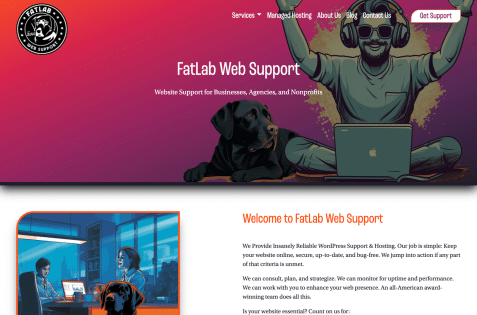Introduction
Web application development, an intricate process that brings ideas to life, is both an art and a science.
It commences with the seed of an idea, a vision for a digital tool that can fulfill a specific need or solve a complex problem. This idea takes form through meticulous planning, designing, building, testing, and refining processes until it finally culminates into a fully functional, custom web application.
This transformative journey, a coalescence of creativity and technology, is often fueled by a deep understanding of user needs and cutting-edge tech solutions. It’s a path of continuous discovery, iteration, and evolution.
The following sections will delve into each phase of this journey, unveiling the magic that turns a simple concept into a powerful web application.
The Rise of Custom Web Application Development

In today’s digital age, bespoke web applications are soaring in popularity, and there are several reasons for this surge in demand. For one, custom web applications are tailored precisely to a business’s requirements, ensuring perfect alignment with its unique processes and objectives. This level of personalization increases operational efficiency and provides a competitive edge.
Secondly, these applications are scalable, growing with the business and adapting to its evolving needs. They offer a level of flexibility that off-the-shelf software often cannot match. Additionally, custom web applications ensure robust security tailored to protect your specific data and business information, which is paramount in a world where cyber threats constantly evolve.
Finally, with bespoke web applications, businesses have the advantage of continuous support and maintenance from the development team, ensuring the software is always up to date and running smoothly. This level of ongoing support further adds to the longevity and effectiveness of the software solution. These factors contribute to the growing demand for custom web application development in the modern digital era.
Custom Web Apps vs. Off-the-Shelf Solutions
Businesses gain substantial benefits when they opt for custom web applications instead of off-the-shelf solutions. Custom web applications offer specificity and fine-tuning that pre-made solutions cannot achieve. They are designed to align seamlessly with your business’s unique processes, objectives, and workflow, enhancing operational efficiency and productivity.
In contrast, off-the-shelf solutions may require businesses to adjust their operations to fit the software, which may not always be optimal or convenient.
Furthermore, custom web applications are inherently more adaptable and scalable. They can grow and evolve along with the business, accommodating new requirements and changes in a streamlined manner. On the other hand, off-the-shelf solutions often come with fixed features, limiting their ability to adapt to changing business needs.
Moreover, custom web applications come with robust, tailored security measures explicitly designed to protect your business data and information. This personalized approach to cybersecurity may not be available with pre-made solutions, which often come with generic security protocols that may not fully cater to your business’s unique security needs.
Lastly, the continuous support and maintenance offered by the developers of custom web apps ensures that your software is always up to date and running smoothly and provides a valuable resource for troubleshooting and enhancements. This level of support may be lacking in off-the-shelf solutions, especially those that are not subscription-based.
In summary, while custom web applications and off-the-shelf solutions have their place, the benefits of customization make it a compelling choice for businesses seeking a flexible, efficient, and effective digital tool.
The Business Value of Custom Web Applications
Custom web applications have the potential to deliver significant business value. First and foremost, these applications drive operational efficiency. Tailored to fit specific business processes, custom web applications eliminate unnecessary features and streamline workflows, reducing waste and improving productivity. Over time, these operational improvements can result in substantial cost savings.
In addition to boosting efficiency, custom web applications can enhance the quality of service delivered to customers. By automating routine tasks, these applications free up employees’ time, allowing them to focus on providing superior customer service. This improved service can increase customer satisfaction, loyalty, and revenue.
Custom web applications also foster innovation. They provide businesses with the tools they need to implement new ideas quickly and efficiently, giving them the flexibility to adapt to changing market conditions and stay ahead of the competition.
Last but not least, custom web apps provide robust data analysis capabilities. By collecting and analyzing data on business operations and customer behavior, these applications can provide valuable insights that drive strategic decision-making. This data-driven approach enables businesses to continually improve their products or services and identify new growth opportunities.
In conclusion, custom web applications offer numerous benefits that enhance operational efficiency, customer service, innovation, and strategic decision-making. By leveraging these benefits, businesses can gain a significant competitive edge and drive growth.
Phase 1: Idea Conception and Needs Assessment

The initial stage of the custom web application development journey is the idea conception and needs assessment phase. This crucial step lays the groundwork for the entire project. It involves identifying the business problem or opportunity the application will address and formulating a high-level idea of its purpose and functions.
During this phase, stakeholders should work closely with the development team to conduct a thorough needs assessment, including determining the application’s primary users, their needs, and the core functionality required to meet them. This process should also outline non-functional requirements like security, performance, and scalability considerations.
An essential part of this phase is defining clear, measurable objectives for the custom web application. These objectives will guide all subsequent stages of development and serve as benchmarks for evaluating the application’s success.
Finally, the idea conception and needs assessment phase should culminate in creating a detailed project scope document. This document will clearly outline the application’s proposed features, functionality, technical requirements, and overall project goals, providing a roadmap for the development process.
Identifying Core Business Needs
Identifying the core business needs the custom web application will address is a pivotal part of the development process. This task involves pinpointing the specific challenges, inefficiencies, or gaps in your current operations that the application is designed to resolve.
This could encompass various issues, from automating time-consuming manual tasks to improving data analysis capabilities. For instance, your business may need a custom application to streamline inventory management, facilitate seamless team communication, or provide detailed analytics to inform strategic decisions.
Moreover, the application should be designed with the end-users in mind – your employees, customers, or partners. Understanding their needs, usage habits, and preferences is critical to delivering a user-friendly application that enhances their interaction with your business.
Furthermore, it’s essential to consider any special requirements that your industry or business model may impose. For instance, if your business handles sensitive personal data, your application will need robust security features to ensure compliance with data protection regulations.
By clearly defining these problems and requirements at the outset, you can ensure that your custom web application is purpose-built to deliver tangible business value. The development team can focus on creating innovative solutions that directly address your identified needs, resulting in a functional application that drives business growth.
Assembling the Right Team
The success of your custom web application development largely depends on the team behind it. The right mix of skills and expertise is crucial for effectively translating your business needs into a functional and innovative application.
The team should ideally consist of the following experts:
- Project Manager (PM): The PM oversees the entire project, ensuring it stays on track regarding time, budget, and scope. The PM also coordinates communication among team members and stakeholders to ensure everyone is aligned with the project goals.
- Business Analyst (BA): The BA understands and translates your business needs into technical requirements. They work closely with the development team and stakeholders to ensure the application meets its intended purpose.
- Software Developers: These individuals write the code that forms the backbone of your application. Their skillset should be aligned with the technologies chosen for the project.
- Quality Assurance (QA) Professionals: QA professionals test the application at different stages of development, identifying and fixing any bugs or issues that could impact its performance or usability.
- User Experience (UX) Designer: The UX Designer ensures the application is intuitive and user-friendly. They craft the user interface based on understanding the end-users’ needs and preferences.
- Stakeholders: Stakeholders are individuals within your organization with a vested interest in the application. They could be executives, department heads, or end-users. Their input is valuable in aligning the application with business objectives and user expectations.
Assembling the right team is half the battle in custom web application development. With this group of experts working cohesively, you can ensure that your application is built to the highest standards and delivers maximum value to your business.
Phase 2: Planning and Design

Mapping Out the Structure and Appearance of the Custom Web Application
After assembling the right team and identifying the business needs, the next step in custom web application development is mapping out the structure and appearance of the application. This stage involves defining the user flow and creating a visual representation of the application, often called wireframing or prototyping.
User Flow
The User Flow is a roadmap of the application — it outlines how users will navigate through the application, highlighting the steps they will take to complete specific tasks. Creating a user flow helps the team understand the user’s perspective, making it easier to design a straightforward and intuitive application.
Wireframing
Wireframing, on the other hand, provides a blueprint of the application’s layout — it depicts the arrangement of elements on each page, including menus, buttons, and content areas. Wireframes are typically simplistic and lack detailed design elements like colors and graphics. Their purpose is to provide a visual guide for the application’s structure.
Prototypes
Closely linked to wireframes are Prototypes. These interactive mockups of the application provide a more accurate depiction of the final product. Prototyping allows the team to gather early feedback on the application’s design and functionality, thereby making it possible to make necessary adjustments before the development phase begins.
Wireframing: The Blueprint of Your Web App
Creating the basic structure and layout of the application, also known as wireframing, is a critical step in web application development. Wireframes are like the blueprints of a building; they outline the application’s architecture, including the position of each element, the navigation, and the general functionality of the site.
Wireframing aims to provide the development team and stakeholders a clear understanding of how the application will work without distractions from visual design elements like colors and typography. This stage of the development process allows for the efficient arrangement of elements to accomplish a particular purpose best.
At this stage, stakeholders can provide feedback, and potential usability issues can be addressed before coding begins. Once the wireframe is approved, it serves as a reference for the design and development teams to proceed with the application creation. Wireframing ensures everyone is on the same page about the application’s structure and functionality, significantly reducing the chances of costly changes later in the development process.
User Experience (UX) Design
User Experience (UX) Design is pivotal in ensuring the application is user-friendly, intuitive, and serves its intended purpose. A UX Designer focuses on creating a seamless interaction between the user and the application. This process involves understanding the user’s needs and expectations and designing the application to meet these requirements.
The UX Designer will consider factors such as usability, accessibility, and performance to create an optimal user experience. This includes creating easy-to-understand navigation, ensuring content is easy to read and understand, and optimizing load times for efficient performance.
UX Design also involves testing and iteration. Using prototyping tools, the design is tested with real users to gather feedback and understand their interaction with the application. This feedback is then used to make improvements, ensuring the final product is aligned with user expectations and business goals.
In essence, UX Design is not just about creating a visually appealing interface but a functional and user-friendly one. It’s about creating an application that users find enjoyable and easy to use, ultimately leading to higher user satisfaction and the application’s success.
User Interface (UI) Design
User Interface (UI) Design is finalizing the custom web application’s look, feel, and interactivity. It is a crucial component of the development process that significantly impacts the user experience. The UI Designer takes the wireframes and prototypes developed during the UX Design phase and adds visual aesthetics, bringing the application to life.
The process involves defining the color scheme, typography, and layout, creating icons and graphics, and designing the interactive elements such as buttons and sliders. The UI Design should be visually appealing and consistent throughout the application, ensuring that the users can easily understand and interact with the interface.
During this stage, it’s vital to maintain a keen focus on the target audience and the intended user experience. The UI Design should be aesthetically pleasing but intuitive and user-friendly, facilitating smooth navigation and ease of use.
Upon the conclusion of the UI Design phase, the application’s look, feel, and interactivity are finalized, paving the way for the development team to begin actual coding. The UI Design is the final visual and interactive blueprint for the custom web application.
Phase 3: Development

The Development phase is the critical juncture where all the meticulous planning and design transform into tangible, functional code. Software engineers or coders take the helm in this phase, using the wireframes, prototypes, and UI designs as blueprints.
The development process is typically divided into the front end and back end. Front-end development involves implementing the UI design, ensuring the application looks and behaves as planned on various devices and browsers.
On the other hand, back-end development focuses on the application’s server side, including databases and server interactions. Rigorous testing accompanies each step to ensure the application is free from bugs and performs optimally under various conditions.
The end goal of the Development phase is to bring the web application to life, making it fully functional, interactive, and ready for User Acceptance Testing (UAT).
Choosing the Right Development Framework
Selecting the appropriate development framework is pivotal to creating a custom web application. A development framework is essentially a software toolkit that provides a structured foundation for the coding and implementation of the application. It can significantly influence the speed of development, the scalability of the application, and the ease of maintenance and updates.
Different frameworks come with their strengths and weaknesses and are better suited to certain types of web applications than others. Therefore, the choice of the framework should be driven by the project’s specific requirements. For instance, Django and Flask are popular choices when working with Python, while Angular, React, and Vue.JS are favored in the JavaScript community.
In making a choice, the development team should consider factors such as the size and complexity of the project, the team’s expertise, the community and support around the framework, and specific features like performance and security capabilities. By carefully selecting the proper development framework, the team paves the way for a more streamlined and efficient development process, ultimately delivering a robust and high-performing web application.
Iterative Development and Version Control
Iterative development is a fundamental aspect of modern web development. Instead of approaching the project as a monolithic whole, it’s divided into manageable sections or ‘iterations.’ Each iteration aims to deliver a working piece of the application, which is then tested and reviewed before moving on to the next. This approach allows for early detection of potential issues or changes, making them less costly to rectify.
On the other hand, version control is an essential practice that helps manage changes and revisions to the codebase. It functions as a system that records changes to a file or set of files over time, allowing you to recall specific versions later. Tools like Git are widely used for version control in the industry, providing a historical record of code changes, aiding in tracking bugs, and facilitating collaboration among the development team.
Implementing iterative development and version control makes the development process more efficient and error-proof, ensuring a smooth transition from one phase to the next, resulting in a robust and efficient web application.
Integrations and Third-party Tools
Incorporating external tools and platforms in a custom web application can significantly enhance its capabilities and provide a superior user experience. By leveraging the power of third-party integrations, we can add advanced features and functionalities to the application without developing them from scratch. This not only accelerates the development process but also ensures the reliability and efficiency of the added feature.
There are numerous third-party tools available today, each serving a unique purpose. These could range from payment gateways like Stripe or PayPal for handling transactions to Google Maps for location services or social media platforms like Facebook and Twitter for social functionality. Tools like Zapier allow for automation between different applications, and APIs from services like AWS or Azure can provide advanced cloud functionalities.
When selecting third-party integrations, it’s essential to consider their compatibility with the existing application, ease of integration, cost, reliability, and the support available. It’s also crucial to ensure that any external integration adheres to the security standards to protect the application and its users’ data. Once integrated, these tools and platforms can significantly enhance the functionality and overall performance of the web application, providing a more comprehensive and seamless user experience.
Phase 4: Testing and Quality Assurance

Ensuring the custom web application is ready for real-world use involves a rigorous Testing and Quality Assurance (QA) phase. During this phase, the application undergoes a series of tests designed to validate all functionalities, verify performance, and ensure security.
This includes functional testing to verify that each feature works as intended, usability testing to ensure a user-friendly experience, and performance testing to assess the application’s response times and stability under various conditions.
Security testing is also crucial to identify and rectify potential vulnerabilities. Additionally, cross-browser and cross-device testing is conducted to confirm that the application provides a consistent and smooth experience across different devices and browsers.
These tests are often automated using tools like Selenium, JMeter, or Zephyr, enabling the QA team to repeat them efficiently whenever changes are made to the application. This thorough testing and QA process is essential to ensure the web application is ready to meet real-world demands and deliver a seamless, secure, and reliable user experience.
Unit Testing and Bug Fixes
Unit testing is integral to the testing process, focusing on examining each web application component in isolation. The objective is to ensure that all individual parts of the system – such as functions, methods, interfaces, or classes – work correctly in isolation. By scrutinizing each code unit, developers can identify and rectify any issues early, enhancing the overall application quality. These tests are typically automated and integrated into the build process, ensuring that new changes do not disrupt the existing functionality.
Bug fixes, on the other hand, involve identifying, analyzing, and correcting the glitches discovered during the testing phases. Bugs could manifest in various forms – from simple user interface errors to complex performance issues or security vulnerabilities. Once identified, each bug is carefully studied to understand its cause and impact before implementing a suitable solution.
This step is critical in ensuring the reliability and robustness of the web application, enhancing its performance, and providing a seamless user experience.
User Acceptance Testing (UAT)
User Acceptance Testing (UAT) is the final yet crucial stage in the testing process. This phase involves the actual users of the web application testing the system in a real-world scenario to ensure it meets their needs and expectations.
The main aim of UAT is to validate that the application is ready for delivery and will function as intended in the hands of the end-users. This includes testing every feature, checking the user interface for intuitiveness and ease of use, and ensuring the system performs well under real-world conditions.
In essence, UAT serves as the last line of defense, identifying any remaining issues that may have been overlooked during the earlier testing phases. The web application is deemed ready for deployment and launch after completing UAT.
Performance and Load Testing
Performance and load testing are significant aspects of the testing process, ensuring the web application can handle its intended user load and operate efficiently under varying conditions.
It involves simulating multiple users accessing the application simultaneously to ascertain its behavior under normal and peak load conditions. Apache JMeter, LoadRunner, or Gatling are often used to simulate a high load and measure the system’s response times, error rates, throughput, and scalability.
This analysis helps identify any bottlenecks in the system, which can be addressed to enhance the application’s performance. A successfully performance-tested application ensures a smooth and high-quality user experience, even under high traffic conditions, building user trust and satisfaction.
Phase 5: Deployment and Launch

Deploying and launching the custom web application marks an exciting milestone in the development process. The application is now ready to serve its purpose and meet the needs of its intended users. At this phase, the application is moved from a development environment to a live production environment, ready to be accessed by users.
Deploying the application involves configuring the production environment, setting up the databases, and ensuring all the necessary systems are in place for the application to function as intended. Once successfully deployed, it’s time to launch the application to its intended audience.
The launch process often involves a comprehensive marketing and communication strategy to effectively introduce the application to its audience. This might include email announcements, press releases, social media campaigns, and other promotional activities to create awareness and generate user interest.
Upon launch, the application is now in the hands of its users, delivering a robust, user-friendly, and secure digital experience that has been carefully crafted through each phase of the development process. It’s a proud moment for the entire development team, marking the culmination of their hard work and dedication. However, the journey doesn’t stop here. Continuous monitoring, maintenance, and improvements are essential to ensure the application remains relevant, reliable, and successful in serving its purpose.
Phase 6: Post-Launch Support and Maintenance

The journey of a web application doesn’t end at launch; it evolves.
Post-launch support and maintenance are crucial phases that ensure the continued success and relevance of the application. During the post-launch phase, the development team closely monitors the application’s performance, addressing any issues that may surface and implementing necessary updates and improvements.
This involves regular server updates, security patches, performance optimization, troubleshooting, and bug fixes, ensuring the application remains up-to-date, secure, and reliable.
Moreover, user feedback is invaluable during this phase, as it provides insights into the user experience, informing necessary enhancements or additions to the feature set.
This phase is a testament to the application’s dynamic nature, constantly learning, evolving, and improving to meet its users’ changing needs and expectations, solidifying its place in the ever-changing digital landscape.
Monitoring and Addressing Issues
Monitoring the performance of a web application post-launch is a non-negotiable aspect of maintaining its reliability and user satisfaction.
Some key performance indicators to track might include load time, user sessions, bounce, and error rates. Performance monitoring tools can provide valuable real-time insights into the application’s functionality and user experience.
Any deviations from the expected performance should be addressed promptly. This might involve troubleshooting the underlying issues, refining the code, optimizing server response times, or scaling resources to handle increased traffic.
Addressing issues as they emerge enhances the overall user experience and safeguards the application’s reputation, fostering trust among its users.
Continuous Improvement and Updates

Continuous improvement and updates are integral to maintaining the relevance and functionality of the custom web application over time.
As technology evolves and user expectations shift, the application must adapt and grow to meet these changing needs. This may involve incorporating new features, enhancements to the user interface, or integration with other evolving technologies.
User feedback is crucial in this process, helping identify improvement and innovation areas. Regular software updates bring about desired improvements and address security vulnerabilities, ensuring the application remains safe and secure.
The web application can ensure longevity and ongoing success by committing to continuous improvement in the competitive digital space.
Conclusion

In revisiting the journey of custom web application development, it is essential to acknowledge its transformative power.
From the initial stages of planning and designing through meticulous coding and testing to the exciting deployment and continuous enhancement post-launch, each phase contributes to creating a digital tool explicitly tailored to the needs of its users.
As technology advances and user needs evolve, the capacity of custom web applications to adapt and innovate demonstrates their invaluable role in today’s digital landscape. The journey is not linear but a constant evolution and improvement cycle underpinned by user feedback and the relentless pursuit of excellence.
This transformative journey not only revolutionizes how users interact with digital platforms but also shapes the future of online interactions and transactions, fostering growth, efficiency, and success in the digital realm.
FAQ
What is the difference between a custom web app and an informational website?
While informational websites primarily provide static content to site visitors, a custom web app offers dynamic functionalities. Web apps are more interactive, allowing user input and personal profiles, and often support specific business processes.
How do custom web app development and mobile app development differ?
Custom web app development focuses on web solutions that run in browsers across various operating systems, whereas mobile apps are native apps explicitly designed for mobile devices. However, progressive web applications bridge this gap, offering web apps with mobile-like experiences.
What are the advantages of choosing a web development company for my project?
A dedicated web development company brings technical expertise, a team of web app developers, business analysts, and a structured web development project approach. They ensure that the custom development aligns with your business strategy and offers the best tech stack for your needs.
Why is user engagement crucial in web app development?
User engagement dictates the success of a web app. Custom web development tailored to enhance user engagement ensures users have a positive experience, leading to better business growth and customer retention.
What are the main stages of the web app development process?
The journey includes defining user stories, choosing the correct programming language, crafting the business logic, software testing, defect management, and further development based on feedback.
How do web portals differ from other web applications?
Web portals are specific types of web applications that provide access to various online portals or online communities, like customer relationship management or online stores. They often allow users to create personal profiles and offer specific functionalities, like an online store or accounting software.
How do web development teams manage multiple developers working on a single project?
With tools like version control systems, web development teams ensure multiple developers can collaborate seamlessly. This ensures efficient defect management, the ability to fix bugs quickly, and a consistent approach to the web project.
What is the significance of choosing the right tech stack in custom web app development?
The tech stack, which includes the programming language, web technologies, and web services, dictates your custom web app’s performance, scalability, and security. A well-chosen stack ensures the app’s longevity and compatibility with future development.
How do progressive web applications fit into the modern web development landscape?
Progressive web applications (PWAs) combine the best of web apps and native apps. They offer offline capabilities, push notifications, and a native-like experience while accessible through search engines and browsers.
How does a business benefit from integrating custom web applications into its operations?
Custom web applications can be tailored to support specific business processes, enhancing efficiency and productivity. Whether it’s a portal web application, accounting software, or customer relationship management tool, these apps drive business growth by optimizing operations and enhancing user engagement.


















